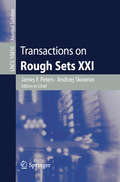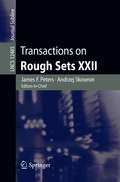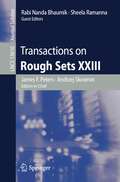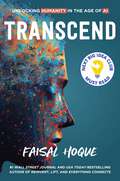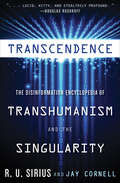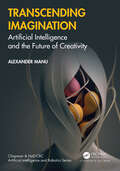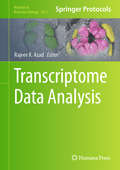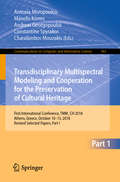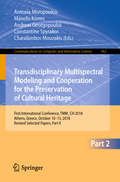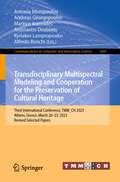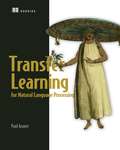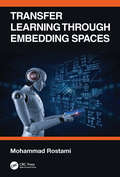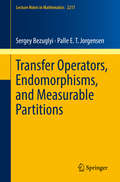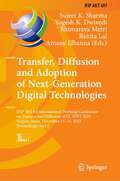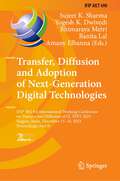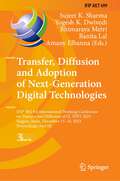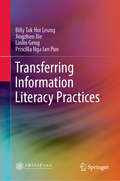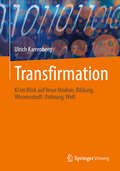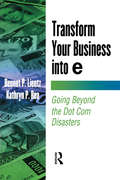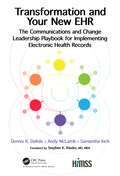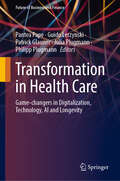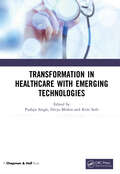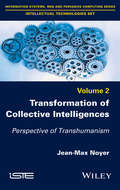- Table View
- List View
Transactions on Rough Sets XXI (Lecture Notes in Computer Science #10810)
by James F. Peters Andrzej SkowronThe LNCS journal Transactions on Rough Sets is devoted to the entire spectrum of rough sets related issues, from logical and mathematical foundations, through all aspects of rough set theory and its applications, such as data mining, knowledge discovery, and intelligent information processing, to relations between rough sets and other approaches to uncertainty, vagueness, and incompleteness, such as fuzzy sets and theory of evidence. Volume XXI in the series is a continuation of a number of research streams that have grown out of the seminal work of Zdzislaw Pawlak during the first decade of the 21st century.
Transactions on Rough Sets XXII (Lecture Notes in Computer Science #12485)
by James F. Peters Andrzej SkowronThe LNCS journal Transactions on Rough Sets is devoted to the entire spectrum of rough sets related issues, from logical and mathematical foundations, through all aspects of rough set theory and its applications, such as data mining, knowledge discovery, and intelligent information processing, to relations between rough sets and other approaches to uncertainty, vagueness, and incompleteness, such as fuzzy sets and theory of evidence. Volume XXII in the series is a continuation of a number of research streams that have grown out of the seminal work of Zdzislaw Pawlak during the first decade of the 21st century.
Transactions on Rough Sets XXIII (Lecture Notes in Computer Science #13610)
by James F. Peters Andrzej Skowron Sheela Ramanna Rabi Nanda BhaumikThe LNCS journal Transactions on Rough Sets is devoted to the entire spectrum of rough sets related issues, from logical and mathematical foundations, through all aspects of rough set theory and its applications, such as data mining, knowledge discovery, and intelligent information processing, to relations between rough sets and other approaches to uncertainty, vagueness, and incompleteness, such as fuzzy sets and theory of evidence. Volume XXIII in the series is a continuation of a number of research streams that have grown out of the seminal work of Zdzislaw Pawlak during the first decade of the 21st century.
Transcend: Unlocking Humanity in the Age of AI
by Faisal HoqueThe question this book answers is, how can we use AI to unlock humanity&’s full potential while protecting what is most precious about the human experience?As humanity takes its first steps into the Age of Artificial Intelligence, we are only just beginning to think through the possibilities and the dangers this technology brings. But we do not have time for leisurely speculation. AI will overturn the world we know in our lifetimes, and we must prepare ourselves to meet the unprecedented changes that will soon be upon us. In Transcend: Unlocking Humanity in the Age of AI, Faisal Hoque, one of the world&’s leading management thinkers and technologists, and a bestselling author, provides readers with the road maps they need to tackle the most important questions of our generation. · A unique perspective that emerges at the intersection of philosophy, humanity, business, and technology · Powerful practical frameworks to guide the reader in thinking about and using AI · The OPEN framework for unlocking the potential of AI · The CARE framework for protecting against its dangers · Structured approaches to AI tailored for individuals, businesses, and government agencies
Transcendence: The Disinformation Encyclopedia of Transhumanism and the Singularity
by R.U. Sirius Jay Cornell&“A deceptively light treatment of mind-blowing technologies and their cultural, social and political impact. This book will put your mind on fire.&”—Giulio Prisco, Hacked.com Transhumanism is an international movement that advocates the use of science and technology to overcome the natural limitations experienced by humanity, through such developments as: the Singularity—the creation of machine intelligences that exceed the capacities of our biological brainsthe ability to replicate individual minds and put them into solid-state bodies or virtual environmentsindividual control over mental and emotional states for enhancing functionalities and/or ecstasies Some of this is happening now. Some it is still in the minds of dreamers. In nearly ninety A-Z entries, Transcendence provides a multilayered look at the accelerating advances in artificial intelligence, cognitive science, genomics, information technology, nanotechnology, neuroscience, space exploration, synthetic biology, robotics, and virtual worlds that are making transhumanism a reality. Entries range from Cloning and Cyborg Feminism to Designer Babies and Memory-Editing Drugs. In addition, the book notes historical predecessors and personalities, both in mythology and history—ranging from Timothy Leary to Michael Jackson to Ray Kurzweil. It also introduces the culture around Transhumanism, covering all the geeky obsessions of the Transhumanist movement. &“A new book deciphering the surreal truths, questionable fictions, and high weirdness of the Singularity . . . Infotaining, irreverent, and frequent piss-taking paperback.&”—Boing Boing &“RU Sirius and Jay Cornell present us with their own psychedelic guide to the galaxy in this adventurous idea-rich book, bootstrapping on emerging technologies that beckon us to take control of our evolutionary destiny and lead humanity towards radical new landscapes of mind, of dream, of cosmos, of possibility.&”—Jason SilvaTranshumanism is an international movement that advocates the use of science and technology to overcome the natural limitations experienced by humanity, through such developments as:the Singularitythe creation of machine intelligences that exceed the capacities of our biological brainsthe ability to replicate individual minds and put them into solid-state bodies or virtual environmentsindividual control over mental and emotional states for enhancing functionalities and/or ecstasiesSome of this is happening now. Some it is still in the minds of dreamers. In nearly ninety A-Z entries,Transcendenceprovides a multilayered look at the accelerating advances in artificial intelligence, cognitive science, genomics, information technology, nanotechnology, neuroscience, space exploration, synthetic biology, robotics, and virtual worlds that are making transhumanism a reality. Entries range from Cloning and Cyborg Feminism to Designer Babies and Memory-Editing Drugs. In addition, the book notes historical predecessors and personalities, both in mythology and historyranging from Timothy Leary to Michael Jackson to Ray Kurzweil. It also introduces the culture around Transhumanism, covering all the geeky obsessions of the Transhumanist movement.
Transcending Imagination: Artificial Intelligence and the Future of Creativity (Chapman & Hall/CRC Artificial Intelligence and Robotics Series)
by Alexander ManuImagine a world where the boundaries of creativity are not only stretched but redefined. This book serves as your guide to this new frontier, engaging general readers, tech enthusiasts, and creatives alike in the captivating interplay between human ingenuity and artificial intelligence (AI).Journey through the ground-breaking advancements in AI as they intersect with art, design, entertainment, and education. Discover how AI’s power to analyze and understand language can be harnessed to generate breathtaking visuals from mere text descriptions—a process known as text-conditional image generation. But this book goes beyond just showcasing AI’s capabilities: it delves into its transformative effects on the creative process itself. How will artists and designers adapt to a world where they co-create with machines? What are the implications of AI-generated art in educational settings? This book tackles these questions head on, offering a comprehensive view of the changing landscape of creativity.At its core, this book challenges you to rethink what’s possible in the realm of artistic expression. Manu contends that as AI evolves, mastering the art of collaboration between human and machine will become essential. More than just a look into the future, Transcending Imagination: Artificial Intelligence and the Future of Creativity is a roadmap for artists, designers, and educators eager to navigate the uncharted territory of AI-augmented creativity. It is a must-read for anyone interested in how AI might redefine the realms of art, design, and education.
Transcriptome Data Analysis (Methods in Molecular Biology #2812)
by Rajeev K. AzadThis detailed volume presents a comprehensive exploration of the advances in transcriptomics, with a focus on methods and pipelines for transcriptome data analysis. In addition to well-established RNA sequencing (RNA-Seq) data analysis protocols, the chapters also examine specialized pipelines, such as multi-omics data integration and analysis, gene interaction network construction, single-cell trajectory inference, detection of structural variants, application of machine learning, and more. As part of the highly successful Methods in Molecular Biology series, chapters include the kind of detailed implementation advice that leads to best results in the lab. Authoritative and practical, Transcriptome Data Analysis serves as an ideal resource for educators and researchers looking to understand new developments in the field, learn usage of the protocols for transcriptome data analysis, and implement the tools or pipelines to address relevant problemsof their interest. Chapter 4 is available open access under a Creative Commons Attribution 4.0 International License via link.springer.com.
Transdisciplinary Multispectral Modeling and Cooperation for the Preservation of Cultural Heritage: First International Conference, TMM_CH 2018, Athens, Greece, October 10–13, 2018, Revised Selected Papers, Part I (Communications in Computer and Information Science #961)
by Antonia Moropoulou Manolis Korres Andreas Georgopoulos Constantine Spyrakos Charalambos MouzakisThis two-volume set CCIS 961 and 962 constitutes the refereed post-conference proceedings of the First International Conference on Transdisciplinary Multispectral Modeling and Cooperation for the Preservation of Cultural Heritage, TMM_CH 2018, held in Athens, Greece, in October 2018.73 revised full papers of 237 submissions are included in these volumes. The papers of the first volume are organized in the following topical sections: the project of the rehabilitation of Holy Sepulchre’s Holy Aedicule as a pilot multispectral, multidimensional, novel approach through transdisciplinary and cooperation in the protection of monuments; digital heritage; novel educational approach for the preservation of monuments; resilience to climate change and natural hazards; conserving sustainably the materiality of structures and architectural authenticity; and interdisciplinary preservation and management of cultural heritage. And the papers of the second volume are organized in the following topical sections: sustainable preservation and management lessons learnt on emblematic monuments; cross-discipline earthquake protection and structural assessment of monuments; cultural heritage and pilgrimage tourism; reuse, circular economy and social participation as a leverage for the sustainable preservation and management of historic cities; inception – inclusive cultural heritage in Europe through 3D semantic modelling; heritage at risk; and advanced and non-destructive techniques for diagnosis, design and monitoring.
Transdisciplinary Multispectral Modeling and Cooperation for the Preservation of Cultural Heritage: First International Conference, TMM_CH 2018, Athens, Greece, October 10–13, 2018, Revised Selected Papers, Part II (Communications in Computer and Information Science #962)
by Antonia Moropoulou Manolis Korres Andreas Georgopoulos Constantine Spyrakos Charalambos MouzakisThis two-volume set CCIS 961 and 962 constitutes the refereed post-conference proceedings of the First International Conference on Transdisciplinary Multispectral Modeling and Cooperation for the Preservation of Cultural Heritage, TMM_CH 2018, held in Athens, Greece, in October 2018. 73 revised full papers of 237 submissions are included in these volumes. The papers of the first volume are organized in the following topical sections: the project of the rehabilitation of Holy Sepulchre’s Holy Aedicule as a pilot multispectral, multidimensional, novel approach through transdisciplinary and cooperation in the protection of monuments; digital heritage; novel educational approach for the preservation of monuments; resilience to climate change and natural hazards; conserving sustainably the materiality of structures and architectural authenticity; and interdisciplinary preservation and management of cultural heritage. And the papers of the second volume are organized in the following topical sections: sustainable preservation and management lessons learnt on emblematic monuments; cross-discipline earthquake protection and structural assessment of monuments; cultural heritage and pilgrimage tourism; reuse, circular economy and social participation as a leverage for the sustainable preservation and management of historic cities; inception – inclusive cultural heritage in Europe through 3D semantic modelling; heritage at risk; and advanced and non-destructive techniques for diagnosis, design and monitoring.
Transdisciplinary Multispectral Modeling and Cooperation for the Preservation of Cultural Heritage: Third International Conference, TMM_CH 2023, Athens, Greece, March 20–23, 2023, Revised Selected Papers (Communications in Computer and Information Science #1889)
by Marinos Ioannides Antonia Moropoulou Anastasios Doulamis Andreas Georgopoulos Alfredo Ronchi Kyriakos LampropoulosThis volume constitutes selected and revised papers presented during the Third International Conference on Trandisciplinary Multispectral Modelling and Cooperation for the Preservation of Cultural Heritage, TMM_CH 2023, held in Athens, Greece, in March 2023. The 17 full papers and 17 short papers presented in ths volume were thoroughly reviewed and selected from 416 submissions. The papers are organized in topical sections on scientific innovations in the diagnosis and preservation of cultural heritage; digital heritage a holistic approach; preservation, reuse and reveal of cultural heritage through sustainable bidding and land management, rural and urban development to recapture the world in crisis through culture.
Transdisciplinary Perspectives on Complex Systems
by Franz-Josef Kahlen Shannon Flumerfelt Anabela AlvesThis book presents an internationally comprehensive perspective into the field of complex systems. It explores the challenges of and approaches to complexity from a broad range of disciplines, including big data, health care, medicine, mathematics, mechanical and systems engineering, air traffic control and finance. The book's interdisciplinary character allows readers to identify transferable and mutually exclusive lessons learned among these disciplines and beyond. As such, it is well suited to the transfer of applications and methodologies between ostensibly incompatible disciplines. This book provides fresh perspectives on comparable issues of complexity from the top minds on systems thinking.
Transfer Learning for Natural Language Processing
by Paul AzunreBuild custom NLP models in record time by adapting pre-trained machine learning models to solve specialized problems.Summary In Transfer Learning for Natural Language Processing you will learn: Fine tuning pretrained models with new domain data Picking the right model to reduce resource usage Transfer learning for neural network architectures Generating text with generative pretrained transformers Cross-lingual transfer learning with BERT Foundations for exploring NLP academic literature Training deep learning NLP models from scratch is costly, time-consuming, and requires massive amounts of data. In Transfer Learning for Natural Language Processing, DARPA researcher Paul Azunre reveals cutting-edge transfer learning techniques that apply customizable pretrained models to your own NLP architectures. You&’ll learn how to use transfer learning to deliver state-of-the-art results for language comprehension, even when working with limited label data. Best of all, you&’ll save on training time and computational costs. Purchase of the print book includes a free eBook in PDF, Kindle, and ePub formats from Manning Publications. About the technology Build custom NLP models in record time, even with limited datasets! Transfer learning is a machine learning technique for adapting pretrained machine learning models to solve specialized problems. This powerful approach has revolutionized natural language processing, driving improvements in machine translation, business analytics, and natural language generation. About the book Transfer Learning for Natural Language Processing teaches you to create powerful NLP solutions quickly by building on existing pretrained models. This instantly useful book provides crystal-clear explanations of the concepts you need to grok transfer learning along with hands-on examples so you can practice your new skills immediately. As you go, you&’ll apply state-of-the-art transfer learning methods to create a spam email classifier, a fact checker, and more real-world applications. What's inside Fine tuning pretrained models with new domain data Picking the right model to reduce resource use Transfer learning for neural network architectures Generating text with pretrained transformers About the reader For machine learning engineers and data scientists with some experience in NLP. About the author Paul Azunre holds a PhD in Computer Science from MIT and has served as a Principal Investigator on several DARPA research programs. Table of Contents PART 1 INTRODUCTION AND OVERVIEW 1 What is transfer learning? 2 Getting started with baselines: Data preprocessing 3 Getting started with baselines: Benchmarking and optimization PART 2 SHALLOW TRANSFER LEARNING AND DEEP TRANSFER LEARNING WITH RECURRENT NEURAL NETWORKS (RNNS) 4 Shallow transfer learning for NLP 5 Preprocessing data for recurrent neural network deep transfer learning experiments 6 Deep transfer learning for NLP with recurrent neural networks PART 3 DEEP TRANSFER LEARNING WITH TRANSFORMERS AND ADAPTATION STRATEGIES 7 Deep transfer learning for NLP with the transformer and GPT 8 Deep transfer learning for NLP with BERT and multilingual BERT 9 ULMFiT and knowledge distillation adaptation strategies 10 ALBERT, adapters, and multitask adaptation strategies 11 Conclusions
Transfer Learning through Embedding Spaces
by Mohammad RostamiRecent progress in artificial intelligence (AI) has revolutionized our everyday life. Many AI algorithms have reached human-level performance and AI agents are replacing humans in most professions. It is predicted that this trend will continue and 30% of work activities in 60% of current occupations will be automated. This success, however, is conditioned on availability of huge annotated datasets to training AI models. Data annotation is a time-consuming and expensive task which still is being performed by human workers. Learning efficiently from less data is a next step for making AI more similar to natural intelligence. Transfer learning has been suggested a remedy to relax the need for data annotation. The core idea in transfer learning is to transfer knowledge across similar tasks and use similarities and previously learned knowledge to learn more efficiently. In this book, we provide a brief background on transfer learning and then focus on the idea of transferring knowledge through intermediate embedding spaces. The idea is to couple and relate different learning through embedding spaces that encode task-level relations and similarities. We cover various machine learning scenarios and demonstrate that this idea can be used to overcome challenges of zero-shot learning, few-shot learning, domain adaptation, continual learning, lifelong learning, and collaborative learning.
Transfer Operators, Endomorphisms, and Measurable Partitions (Lecture Notes in Mathematics #2217)
by Sergey Bezuglyi Palle E. JorgensenThe subject of this book stands at the crossroads of ergodic theory and measurable dynamics. With an emphasis on irreversible systems, the text presents a framework of multi-resolutions tailored for the study of endomorphisms, beginning with a systematic look at the latter. This entails a whole new set of tools, often quite different from those used for the “easier” and well-documented case of automorphisms. Among them is the construction of a family of positive operators (transfer operators), arising naturally as a dual picture to that of endomorphisms. The setting (close to one initiated by S. Karlin in the context of stochastic processes) is motivated by a number of recent applications, including wavelets, multi-resolution analyses, dissipative dynamical systems, and quantum theory. The automorphism-endomorphism relationship has parallels in operator theory, where the distinction is between unitary operators in Hilbert space and more general classes of operators such as contractions. There is also a non-commutative version: While the study of automorphisms of von Neumann algebras dates back to von Neumann, the systematic study of their endomorphisms is more recent; together with the results in the main text, the book includes a review of recent related research papers, some by the co-authors and their collaborators.
Transfer, Diffusion and Adoption of Next-Generation Digital Technologies: IFIP WG 8.6 International Working Conference on Transfer and Diffusion of IT, TDIT 2023, Nagpur, India, December 15–16, 2023, Proceedings, Part I (IFIP Advances in Information and Communication Technology #697)
by Yogesh K. Dwivedi Banita Lal Amany Elbanna Sujeet K. Sharma Bhimaraya MetriThis book constitutes the refereed proceedings of the IFIP WG 8.6 International Working Conference on Transfer and Diffusion of IT, TDIT 2023, which took place in Nagpur, India, in December 2023. The 87 full papers and 23 short papers presented in these proceedings were carefully reviewed and selected from 209 submissions. The papers are organized in the following topical sections:Volume I:Digital technologies (artificial intelligence) adoption; digital platforms and applications; digital technologies in e-governance; metaverse and marketing.Volume II:Emerging technologies adoption; general IT adoption; healthcare IT adoption.Volume III:Industry 4.0; transfer, diffusion and adoption of next-generation digital technologies; diffusion and adoption of information technology.
Transfer, Diffusion and Adoption of Next-Generation Digital Technologies: IFIP WG 8.6 International Working Conference on Transfer and Diffusion of IT, TDIT 2023, Nagpur, India, December 15–16, 2023, Proceedings, Part II (IFIP Advances in Information and Communication Technology #698)
by Yogesh K. Dwivedi Banita Lal Amany Elbanna Sujeet K. Sharma Bhimaraya MetriThis book constitutes the refereed proceedings of the IFIP WG 8.6 International Working Conference on Transfer and Diffusion of IT, TDIT 2023, which took place in Nagpur, India, in December 2023. The 87 full papers and 23 short papers presented in these proceedings were carefully reviewed and selected from 209 submissions. The papers are organized in the following topical sections: Volume I: Digital technologies (artificial intelligence) adoption; digital platforms and applications; digital technologies in e-governance; metaverse and marketing. Volume II: Emerging technologies adoption; general IT adoption; healthcare IT adoption. Volume III: Industry 4.0; transfer, diffusion and adoption of next-generation digital technologies; diffusion and adoption of information technology.
Transfer, Diffusion and Adoption of Next-Generation Digital Technologies: IFIP WG 8.6 International Working Conference on Transfer and Diffusion of IT, TDIT 2023, Nagpur, India, December 15–16, 2023, Proceedings, Part III (IFIP Advances in Information and Communication Technology #699)
by Yogesh K. Dwivedi Banita Lal Amany Elbanna Sujeet K. Sharma Bhimaraya MetriThis book constitutes the refereed proceedings of the IFIP WG 8.6 International Working Conference on Transfer and Diffusion of IT, TDIT 2023, which took place in Nagpur, India, in December 2023. The 87 full papers and 23 short papers presented in these proceedings were carefully reviewed and selected from 209 submissions. The papers are organized in the following topical sections: Volume I: Digital technologies (artificial intelligence) adoption; digital platforms and applications; digital technologies in e-governance; metaverse and marketing. Volume II: Emerging technologies adoption; general IT adoption; healthcare IT adoption. Volume III: Industry 4.0; transfer, diffusion and adoption of next-generation digital technologies; diffusion and adoption of information technology.
Transferring Information Literacy Practices
by Billy Tak Leung Jingzhen Xie Linlin Geng Priscilla Nga PunThis book focuses on information literacy for the younger generation of learners and library readers. It is divided into four sections: 1. Information Literacy for Life; 2. Searching Strategies, Disciplines and Special Topics; 3. Information Literacy Tools for Evaluating and Utilizing Resources; 4. Assessment of Learning Outcomes. Written by librarians with wide experience in research and services, and a strong academic background in disciplines such as the humanities, social sciences, information technology, and library science, this valuable reference resource combines both theory and practice. In today's ever-changing era of information, it offers students of library and information studies insights into information literacy as well as learning tips they can use for life.
Transfirmation: KI im Blick auf Neue Medien, Bildung, Wissenschaft. Ordnung, Welt
by Ulrich KarrenbergDieses Buch widmet sich der Frage, wie KI als treibende Kraft in den Bereichen Medien, Bildung, Wissenschaft, gesellschaftlicher Ordnung und unserer globalen Welt wirkt. Es ist eine Einladung, nicht nur zu verstehen, was diese Technologien bewirken, sondern auch, welche Möglichkeiten und Herausforderungen sich daraus ergeben.
Transform Your Business into E
by Bennet Lientz Kathryn ReaSurveys indicate that many E-Business efforts either fail or disrupt the basic business processes and transactions. E-Business is sometimes not aligned with the business or IT. Vague vision statements are not translated into specific actions related to E- Business. It is because of these factors that Transform Your Business into e was written. The book covers E-Business from the review of the business at the start to expanding E-Business after it is live.
Transformation and Your New EHR: The Communications and Change Leadership Playbook for Implementing Electronic Health Records (HIMSS Book Series)
by Andy McLamb Samantha Inch Dennis DelisleTransformation and Your New EHR offers a robust communication and change leadership approach to support electronic health record (EHR) implementations and transformation journeys. This book highlights the approach and philosophy of communication, change leadership, and systems and process design, giving readers a practical view into the successes and failures that can be experienced throughout the evolution of an EHR implementation.
Transformation in Health Care: Game-changers in Digitalization, Technology, AI and Longevity (Future of Business and Finance)
by Philipp Plugmann Patrick Glauner Guido Lerzynski Julia Plugmann Pantea PapeThis edited book discusses the new technologies and innovations on the horizon. Transformation in healthcare is often focused on technology and digitalization, but it's always a combination of technology and humans, akin to a team play. How can digitalization in healthcare propel us forward, and what types of interactions with teams and patients are possible in the future? The transformative nature of new technologies, products, services, procedures, and organizations will shape the future of healthcare and business models. The book also explains why management skills must be developed to meet the needs of customers and patients in the upcoming decade.
Transformation in Healthcare with Emerging Technologies
by Kirti Seth Pushpa Singh Divya MishraThe book, Transformation in Healthcare with Emerging Technologies, presents healthcare industrial revolution based on service aggregation and virtualisation that can transform the healthcare sector with the aid of technologies such as Artificial Intelligence (AI), Internet of Things (IoT), Bigdata and Blockchain. These technologies offer fast communication between doctors and patients, protected transactions, safe data storage and analysis, immutable data records, transparent data flow service, transaction validation process, and secure data exchanges between organizations. Features: • Discusses the Integration of AI, IoT, big data and blockchain in healthcare industry • Highlights the security and privacy aspect of AI, IoT, big data and blockchain in healthcare industry • Talks about challenges and issues of AI, IoT, big data and blockchain in healthcare industry • Includes several case studies It is primarily aimed at graduates and researchers in computer science and IT who are doing collaborative research with the medical industry. Industry professionals will also find it useful.
Transformation of Collective Intelligences: Perspective of Transhumanism
by Jean-Max NoyerThere is a great transformation of the production of knowledge and intelligibility. The "digital fold of the world" (with the convergence of NBIC) affects the collective assemblages of "thought", of research. The aims of these assemblages are also controversial issues. From a general standpoint, these debates concern "performative science and performative society". But one emerges and strengthens that has several names: transhumanism, post-humanism, speculative post-humanism. It appears as a great narration, a large story about the future of our existence, facing our entry into the Anthropocene. It is also presented as a concrete utopia with an anthropological and technical change. In this book, we proposed to show how collective intelligences stand in the middle of the coupling of ontological horizons and of the "process of bio-technical maturation".
Transformational Security Awareness: What Neuroscientists, Storytellers, and Marketers Can Teach Us About Driving Secure Behaviors
by Perry CarpenterExpert guidance on the art and science of driving secure behaviors Transformational Security Awareness empowers security leaders with the information and resources they need to assemble and deliver effective world-class security awareness programs that drive secure behaviors and culture change. When all other processes, controls, and technologies fail, humans are your last line of defense. But, how can you prepare them? Frustrated with ineffective training paradigms, most security leaders know that there must be a better way. A way that engages users, shapes behaviors, and fosters an organizational culture that encourages and reinforces security-related values. The good news is that there is hope. That’s what Transformational Security Awareness is all about. Author Perry Carpenter weaves together insights and best practices from experts in communication, persuasion, psychology, behavioral economics, organizational culture management, employee engagement, and storytelling to create a multidisciplinary masterpiece that transcends traditional security education and sets you on the path to make a lasting impact in your organization. Find out what you need to know about marketing, communication, behavior science, and culture management Overcome the knowledge-intention-behavior gap Optimize your program to work with the realities of human nature Use simulations, games, surveys, and leverage new trends like escape rooms to teach security awareness Put effective training together into a well-crafted campaign with ambassadors Understand the keys to sustained success and ongoing culture change Measure your success and establish continuous improvements Do you care more about what your employees know or what they do? It's time to transform the way we think about security awareness. If your organization is stuck in a security awareness rut, using the same ineffective strategies, materials, and information that might check a compliance box but still leaves your organization wide open to phishing, social engineering, and security-related employee mistakes and oversights, then you NEED this book.
